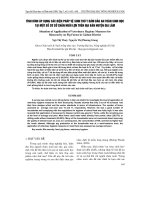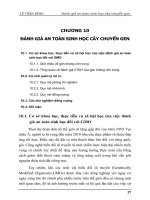Đại cương về An toàn sinh học pptx
Bạn đang xem bản rút gọn của tài liệu. Xem và tải ngay bản đầy đủ của tài liệu tại đây (1.77 MB, 28 trang )
Lịch học: Thứ 4, Tiết 4-6
Học kỳ II, 2010-2011
Giảng Viên: TS. Nguyễn Thị Phương Thảo
Bộ môn CNSH Thực Vật; Khoa CNSH
Mobile:0912630268
Email:
Chương 1: Đại cương về an toàn sinh học
Chương 2: An toàn sinh học và GMO
Chương 3:Phân tích khoa học các rủi ro của sinh vật biến đổi di
truyền
Chương 4: Đánh giá rủi ro
Chương 5: Quản lý rủi ro
Chương 6: Các công ước và thỏa thuận quốc tế về an toàn sinh học
Chương 7:Thái độ và nhận thức của xã hội về an toàn sinh học
Chương 8: Quản lý an toàn sinh học trên thế giới và ở Việt nam
Kiến tập (dự kiến): thăm ruộng khảo nghiệm cây trồng biến đổi gen
Theo tài liệu hướng dẫn phát trên lớp
2 bài thảo luận: 30%
2 bài kiểm tra 10’ : 20 %
Thi cuối kỳ = 50%
Safety from exposure to
Infectious Agents
Smallpox
ECOLOGY: referring to
imported life forms not
indigenous to the region (Reggie
the alligator)
AGRICULTURE: reducing the
risk of alien viral or transgenic
genes, or prions such as
BSE/"MadCow“; reducing the
risk of food bacterial
contamination
MEDICINE: referring to
organs or tissues from
biological origin, or genetic
therapy products, virus; levels
of lab containment protocols
BSL-1, 2, 3, 4 in rising order of
danger
CHEMISTRY: i.e., nitrates in
water, PCB levels affecting
fertility
EXOBIOLOGY: i.e., NASA's
policy for containing alien
microbes that may exist on
space samples - sometimes
called "biosafety level 5"
Charles Baldwin at
National Cancer
Institute at NIH.
Symbol to be
“memorable but
meaningless” so it
could be learned.
Blaze orange – most
visible under harsh
conditions
Laboratory Safety
Bloodborne pathogens (BBP)
Recombinant DNA (rDNA)
Biological waste disposal
Infectious substance and
diagnostic specimen shipping
Respiratory Protection
Bioterrorism and Select agents
Mold and indoor air quality
Occupational safety and health in the use of research
animals
Biohazards used in animal models
Viruses
Bacteria
Fungi
Chlamydiae/Rickettsiae
Prions
Recombinant DNA
“If you would understand anything, observe its beginning and its
development.”
Sơ lược lịch sử về an toàn sinh học
1854 London cholera epidemic
Edwin Chadwick and John Snow
Water pollution and disease transmission
Ignited “the sanitation revolution”
1885 Typhoid (thương hàn) lab infection, unknown cause
1893 Tetanus (uốn ván) lab infection by syringe
1894 Cholera (tả) lab infection by pipette
1897 Brucella lab infection by syringe
1898 Glanders (lở loét) lab infection by syringe
1899 Diphtheria (bạch hầu) lab infection by pipette
First Laboratory Infections
Pasteur established the germ theory in 1862
– Demonstrated that fermentation is caused by the growth of
microorganisms; published paper on lactic fermentation in 1857
Isolation and culturing of bacteria
– Robert Koch: Bacillus anthracis - 1877; tuberculosis bacilli - 1882;
Vibrio cholera - 1883; Corynebacterium diphtheriae - 1881- 1884;
Salmonella typhi – 1884 (Gaffky); Yersinia pestis - 1894 (Yersin)
– David Bruce: Brucella melitensis - 1887
Germ Theory
Kisskalt, K. 1915. Laboratory Infections with Typhoid Bacilli.
Zeitschrift fur Hygiene and Infektionskrankheiten 80:145-162
Meyer,K.F. and Eddie, B. 1941. Laboratory Infections Due to
Brucella. J. Infect. Dis. 68:24-32
Sulkin, S. E. and Pike, R.M. 1951. Survey of Laboratory-Acquired
Infections. Amer. J. Public Health 41:769-781
Pike, R.M. 1976. Laboratory-associated Infections: Summary and
Analysis of 3921 Cases. Health Laboratory Science 13:105-114
Surveys of Laboratory Infections
Surveys of Laboratory Infections
and Biomedical Laboratories
“BMBL” (acronym)
CDC/NIH Publication
Safety “Guidelines”
Regulations of Institution receives
NIH funding
Code of Practice and “Gold” Standard in
Industry anl
Gold Standard
Clinical & Research Lab.
Lab. Animal Facilities
Biosafety Concepts
HHS Publication No. (CDC) 93-8395
/>5/bmbl5toc.htm
and animal pathogens,
(2) possibility of creation of 'hybrid organisms' with
biological activities of an unpredictable nature, and
(3) the escape of 'hybrid organisms' from the laboratory
with unpredictable consequences.
Paul Berg đã tổ chức hội nghị quốc tế về kỹ thuật DNA tái tổ hợp với hơn
130 nhà khoa học khác để thảo luận về những gì đã biết (cũng như chưa
biết) về DNA tái tổ hợp và đề ra một số nguyên tắc chỉ đạo giúp các nhà
khoa học tránh được những nguy cơ không đáng có. Các nhà khoa học
đã đồng ý tạm dừng nghiên cứu liên quan đến các kỹ thuật DNA tái tổ
hợp cho đến khi xác định được các nguy cơ tiềm ẩn.
Asilomar Conference on Recombinant DNA
Molecules February 24 - 27, 1975
(ii) most of the work on recombinant DNA could
proceed with appropriate safety measures,
(iii) potential risks were assigned to different types of
experiments, and
(iv) such safe bacteria and plasmids that could not
survive in the environment if they escaped from the
laboratory should be developed.









